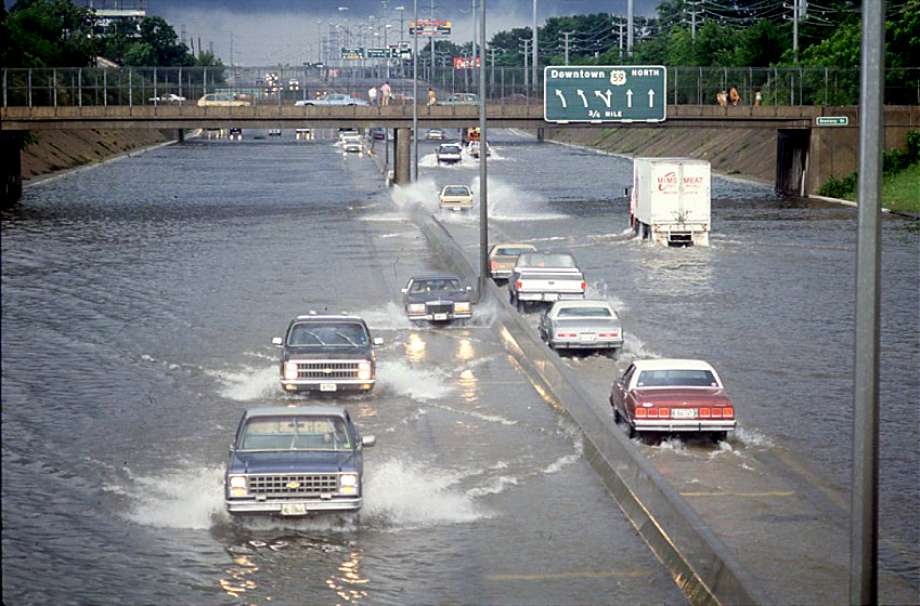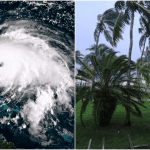Harvey, the most powerful hurricane to strike Texas in more than 50 years, first hit land late on Friday and has killed at least two people. It has since lingered around Texas’ Gulf Coast, where it is forecast to remain for several more days, drenching parts of the region with a year’s worth of rain in the span of a week.
Schools, airports and office buildings in the nation’s fourth largest city were ordered shut on Monday as scores of roads turned into rivers and chest-high water filled neighborhoods in the low-lying city that is home to about 2.3 million people. The area’s vital petrochemcial industry also was crippled.
Torrential rain also hit areas more than 150 miles (240 km) away, swelling rivers upstream and causing a surge that was heading toward the Houston area, where numerous rivers and streams already have been breached.
More flooding is expected as water levels continue to rise, putting more residents at risk. More than 30,000 people are expected to be placed temporarily in shelters, FEMA Administrator Brock Long said at a news conference on Monday. The National Weather Service said the worst of floods are expected Wednesday and Thursday, although there is still uncertainty over the storm’s path.
The U.S. Army Corps of Engineers said Monday that it was releasing water from two nearby reservoirs into Buffalo Bayou, the primary body of water running through Houston.
“If we don’t begin releasing now, the volume of uncontrolled water around the dams will be higher and have a greater impact on the surrounding communities,” said Colonel Lars Zetterstrom, Galveston district commander of the Corps.
The Harris County Flood Control District said it expected the release to start flooding homes around the Addicks and Barker reservoirs on Monday morning.
Harvey, the most powerful hurricane to strike Texas in more than 50 years, first hit land late on Friday and has killed at least two people. It has since lingered around Texas’ Gulf Coast, where it is forecast to remain for several more days, drenching parts of the region with a year’s worth of rain in the span of a week.
Schools, airports and office buildings in the nation’s fourth largest city were ordered shut on Monday as scores of roads turned into rivers and chest-high water filled neighborhoods in the low-lying city that is home to about 2.3 million people. The area’s vital petrochemcial industry also was crippled.
Torrential rain also hit areas more than 150 miles (240 km) away, swelling rivers upstream and causing a surge that was heading toward the Houston area, where numerous rivers and streams already have been breached.
More flooding is expected as water levels continue to rise, putting more residents at risk. More than 30,000 people are expected to be placed temporarily in shelters, FEMA Administrator Brock Long said at a news conference on Monday. The National Weather Service said the worst of floods are expected Wednesday and Thursday, although there is still uncertainty over the storm’s path.
The U.S. Army Corps of Engineers said Monday that it was releasing water from two nearby reservoirs into Buffalo Bayou, the primary body of water running through Houston.
“If we don’t begin releasing now, the volume of uncontrolled water around the dams will be higher and have a greater impact on the surrounding communities,” said Colonel Lars Zetterstrom, Galveston district commander of the Corps.
The Harris County Flood Control District said it expected the release to start flooding homes around the Addicks and Barker reservoirs on Monday morning.
Harvey, the most powerful hurricane to strike Texas in more than 50 years, first hit land late on Friday and has killed at least two people. It has since lingered around Texas’ Gulf Coast, where it is forecast to remain for several more days, drenching parts of the region with a year’s worth of rain in the span of a week.
Schools, airports and office buildings in the nation’s fourth largest city were ordered shut on Monday as scores of roads turned into rivers and chest-high water filled neighborhoods in the low-lying city that is home to about 2.3 million people. The area’s vital petrochemcial industry also was crippled.
Torrential rain also hit areas more than 150 miles (240 km) away, swelling rivers upstream and causing a surge that was heading toward the Houston area, where numerous rivers and streams already have been breached.
More flooding is expected as water levels continue to rise, putting more residents at risk. More than 30,000 people are expected to be placed temporarily in shelters, FEMA Administrator Brock Long said at a news conference on Monday. The National Weather Service said the worst of floods are expected Wednesday and Thursday, although there is still uncertainty over the storm’s path.
The U.S. Army Corps of Engineers said Monday that it was releasing water from two nearby reservoirs into Buffalo Bayou, the primary body of water running through Houston.
“If we don’t begin releasing now, the volume of uncontrolled water around the dams will be higher and have a greater impact on the surrounding communities,” said Colonel Lars Zetterstrom, Galveston district commander of the Corps.
The Harris County Flood Control District said it expected the release to start flooding homes around the Addicks and Barker reservoirs on Monday morning.
Harvey, the most powerful hurricane to strike Texas in more than 50 years, first hit land late on Friday and has killed at least two people. It has since lingered around Texas’ Gulf Coast, where it is forecast to remain for several more days, drenching parts of the region with a year’s worth of rain in the span of a week.
Schools, airports and office buildings in the nation’s fourth largest city were ordered shut on Monday as scores of roads turned into rivers and chest-high water filled neighborhoods in the low-lying city that is home to about 2.3 million people. The area’s vital petrochemcial industry also was crippled.
Torrential rain also hit areas more than 150 miles (240 km) away, swelling rivers upstream and causing a surge that was heading toward the Houston area, where numerous rivers and streams already have been breached.
More flooding is expected as water levels continue to rise, putting more residents at risk. More than 30,000 people are expected to be placed temporarily in shelters, FEMA Administrator Brock Long said at a news conference on Monday. The National Weather Service said the worst of floods are expected Wednesday and Thursday, although there is still uncertainty over the storm’s path.
The U.S. Army Corps of Engineers said Monday that it was releasing water from two nearby reservoirs into Buffalo Bayou, the primary body of water running through Houston.
“If we don’t begin releasing now, the volume of uncontrolled water around the dams will be higher and have a greater impact on the surrounding communities,” said Colonel Lars Zetterstrom, Galveston district commander of the Corps.
The Harris County Flood Control District said it expected the release to start flooding homes around the Addicks and Barker reservoirs on Monday morning.
Harvey, the most powerful hurricane to strike Texas in more than 50 years, first hit land late on Friday and has killed at least two people. It has since lingered around Texas’ Gulf Coast, where it is forecast to remain for several more days, drenching parts of the region with a year’s worth of rain in the span of a week.
Schools, airports and office buildings in the nation’s fourth largest city were ordered shut on Monday as scores of roads turned into rivers and chest-high water filled neighborhoods in the low-lying city that is home to about 2.3 million people. The area’s vital petrochemcial industry also was crippled.
Torrential rain also hit areas more than 150 miles (240 km) away, swelling rivers upstream and causing a surge that was heading toward the Houston area, where numerous rivers and streams already have been breached.
More flooding is expected as water levels continue to rise, putting more residents at risk. More than 30,000 people are expected to be placed temporarily in shelters, FEMA Administrator Brock Long said at a news conference on Monday. The National Weather Service said the worst of floods are expected Wednesday and Thursday, although there is still uncertainty over the storm’s path.
The U.S. Army Corps of Engineers said Monday that it was releasing water from two nearby reservoirs into Buffalo Bayou, the primary body of water running through Houston.
“If we don’t begin releasing now, the volume of uncontrolled water around the dams will be higher and have a greater impact on the surrounding communities,” said Colonel Lars Zetterstrom, Galveston district commander of the Corps.
The Harris County Flood Control District said it expected the release to start flooding homes around the Addicks and Barker reservoirs on Monday morning.
Harvey, the most powerful hurricane to strike Texas in more than 50 years, first hit land late on Friday and has killed at least two people. It has since lingered around Texas’ Gulf Coast, where it is forecast to remain for several more days, drenching parts of the region with a year’s worth of rain in the span of a week.
Schools, airports and office buildings in the nation’s fourth largest city were ordered shut on Monday as scores of roads turned into rivers and chest-high water filled neighborhoods in the low-lying city that is home to about 2.3 million people. The area’s vital petrochemcial industry also was crippled.
Torrential rain also hit areas more than 150 miles (240 km) away, swelling rivers upstream and causing a surge that was heading toward the Houston area, where numerous rivers and streams already have been breached.
More flooding is expected as water levels continue to rise, putting more residents at risk. More than 30,000 people are expected to be placed temporarily in shelters, FEMA Administrator Brock Long said at a news conference on Monday. The National Weather Service said the worst of floods are expected Wednesday and Thursday, although there is still uncertainty over the storm’s path.
The U.S. Army Corps of Engineers said Monday that it was releasing water from two nearby reservoirs into Buffalo Bayou, the primary body of water running through Houston.
“If we don’t begin releasing now, the volume of uncontrolled water around the dams will be higher and have a greater impact on the surrounding communities,” said Colonel Lars Zetterstrom, Galveston district commander of the Corps.
The Harris County Flood Control District said it expected the release to start flooding homes around the Addicks and Barker reservoirs on Monday morning.
Harvey, the most powerful hurricane to strike Texas in more than 50 years, first hit land late on Friday and has killed at least two people. It has since lingered around Texas’ Gulf Coast, where it is forecast to remain for several more days, drenching parts of the region with a year’s worth of rain in the span of a week.
Schools, airports and office buildings in the nation’s fourth largest city were ordered shut on Monday as scores of roads turned into rivers and chest-high water filled neighborhoods in the low-lying city that is home to about 2.3 million people. The area’s vital petrochemcial industry also was crippled.
Torrential rain also hit areas more than 150 miles (240 km) away, swelling rivers upstream and causing a surge that was heading toward the Houston area, where numerous rivers and streams already have been breached.
More flooding is expected as water levels continue to rise, putting more residents at risk. More than 30,000 people are expected to be placed temporarily in shelters, FEMA Administrator Brock Long said at a news conference on Monday. The National Weather Service said the worst of floods are expected Wednesday and Thursday, although there is still uncertainty over the storm’s path.
The U.S. Army Corps of Engineers said Monday that it was releasing water from two nearby reservoirs into Buffalo Bayou, the primary body of water running through Houston.
“If we don’t begin releasing now, the volume of uncontrolled water around the dams will be higher and have a greater impact on the surrounding communities,” said Colonel Lars Zetterstrom, Galveston district commander of the Corps.
The Harris County Flood Control District said it expected the release to start flooding homes around the Addicks and Barker reservoirs on Monday morning.
Harvey, the most powerful hurricane to strike Texas in more than 50 years, first hit land late on Friday and has killed at least two people. It has since lingered around Texas’ Gulf Coast, where it is forecast to remain for several more days, drenching parts of the region with a year’s worth of rain in the span of a week.
Schools, airports and office buildings in the nation’s fourth largest city were ordered shut on Monday as scores of roads turned into rivers and chest-high water filled neighborhoods in the low-lying city that is home to about 2.3 million people. The area’s vital petrochemcial industry also was crippled.
Torrential rain also hit areas more than 150 miles (240 km) away, swelling rivers upstream and causing a surge that was heading toward the Houston area, where numerous rivers and streams already have been breached.
More flooding is expected as water levels continue to rise, putting more residents at risk. More than 30,000 people are expected to be placed temporarily in shelters, FEMA Administrator Brock Long said at a news conference on Monday. The National Weather Service said the worst of floods are expected Wednesday and Thursday, although there is still uncertainty over the storm’s path.
The U.S. Army Corps of Engineers said Monday that it was releasing water from two nearby reservoirs into Buffalo Bayou, the primary body of water running through Houston.
“If we don’t begin releasing now, the volume of uncontrolled water around the dams will be higher and have a greater impact on the surrounding communities,” said Colonel Lars Zetterstrom, Galveston district commander of the Corps.
The Harris County Flood Control District said it expected the release to start flooding homes around the Addicks and Barker reservoirs on Monday morning.













